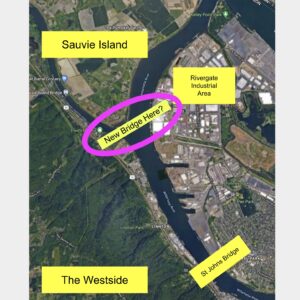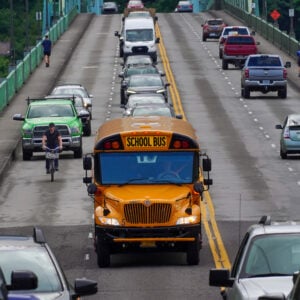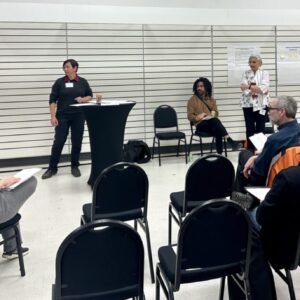I got a surprising phone call yesterday from ODOT regional manager Charles Sciscione. He was responding to my post back on June 15th titled, St. Johns Bridge still unsafe after 75 years.
I wrote that post out of frustration that ODOT was celebrating the 75 year anniversary of the bridge by touting the recent renovation as providing “better pedestrian and bicycle access.”
After that post I got a tip from someone at PDOT saying Sciscione came into the situation late in the game but that he had shown interest in bike safety issues and was warm to the idea of putting sharrows (shared lane markings) on the bridge. I encouraged cyclists to contact him and even emailed him myself asking for an update.
We had a good conversation. We talked about the possibilities for improving the safety of the bridge for cyclists and how ODOT might start to improve their reputation in the cycling community.
Sciscione seemed open to the idea of sharrows, but has no plans to move forward with them because at this point they’re still an experimental marking without official approval from the Federal Highway Administration (FHWA) (it’s true, I confirmed this with PDOT’s head bike guy Roger Geller…I’ll have more info on this later).
As for bike lanes on the bridge? Sciscione says,
“Unfortunately that’ll never happen. I think it’d be great to have bike lanes, but we’re in a bad place because there’s simply not a lot of room to work with*.”
*(the bridge has 4 motor vehicle lanes and no shoulder)
Sciscione says they’re going to add several new “Shared Roadway” signs to each end of the bridge. He also mentioned they are considering a permanent electronic message board sign that could display safety messages.
I suggested a flashing sign that could be activated by cyclists that says, “Caution, bikes on roadway.” This type of treatment is sometimes used in tunnels and on narrow sections of Highway 1. Sciscione liked that idea and said he’ll run it by his co-workers at an upcoming meeting.
I think it’s important to let ODOT know that the bike community has not forgotten about this issue and that we are very interested in working with them to add as many bike safety improvements as possible.
On that note, I was impressed to hear Sciscione’s candid acknowledgement of ODOT’s rocky relationship with cyclists. He said that they simply had a “difference of opinion” on the St. Johns Bridge and that he hopes we can move on and “start cementing relationships.”
I told him about my good and bad experiences with ODOT and offered my site as a way to forge a more transparent and constructive dialogue with the bike community.
He was thrilled with my offer and said he looks forward to “making amends with cyclists” and working more closely with us on future projects and decisions.
As proof that he wasn’t just telling me what I wanted to hear, soon after our conversation I received an email from him (CC’d to several other ODOT staffers) that re-iterated his desire to work directly with the community through this site.
So just how can a big state agency like ODOT work with a little community blog?
Look how PDOT does it. They wanted feedback on their new “Welcome to Portland” border signs and the readers of this site delivered.
Sciscione seems to get it already:
“I think we’re on the same page in regards to increased efforts to engage the bicycling community early in design stages of construction projects, and to include discussions of construction staging, traffic control, and detours as well as the final product.”
I see this as a real opportunity and I look forward to a more candid and constructive dialogue with ODOT from here on out.
Now, what to do about that bridge…





Thanks for reading.
BikePortland has served this community with independent community journalism since 2005. We rely on subscriptions from readers like you to survive. Your financial support is vital in keeping this valuable resource alive and well.
Please subscribe today to strengthen and expand our work.
“Unfortunately that’ll never happen.”
Bike lanes WILL happen when the political leaders make ODOT do it. It was brought up last night at a community meeting with Ted Wheeler, and it will continue to be brought up until resolved.
The consultants’ studies show that having bike lanes would not significantly disrupt traffic, and that the congestion issues aren’t on the bridge, they’re at the intersections at the ends of the bridge. We need our leaders — specifically, the Oregon Transportation Commission — to realize that bike safety should not be traded off for a few seconds of travel time.
The BTA will continue to fight for the St. Johns’ Bridge to be safe and welcoming for people of all modes.
Portland is stalling on the installation of sharrows, hiding behind the misconception that sharrows cannot be utilized until they are incorporated into the Manual of Uniform Traffic Control Devices (MUTCD). Here’s the fallacy: PDOT and ODOT are not required to follow the MUTCD; the MUTCD consists of guidelines only. Other bicycle treatments are being used that aren’t in the MUTCD and sharrows are already in use in San Francisco and other US cities; Portland should follow suit. The MUTCD will catch up eventually.
I agree with Evan — the St Johns Bridge just doesn’t have the volume of traffic to necessitate 2 lanes for autos in each direction. In St. Johns, after the initial touch-down, there is only one lane in each direction… and if you don’t count the climbing lane, there is only one lane in each direction leading to the bridge from Hwy 30! So, why insist on two lanes in each direction across the bridge? To make it easier for autos to speed when they pass a truck or bus? What’s the big hurry?
A really sound retrofit of this bridge would narrow it to one auto lane in each direction, possible separated by rumble strips or something else to prevent people from crossing the center line. Then, a bike lane in each direction — with no rumble strips, in case a bicyclist needs to enter the traffic lane to avoid debris. Finally, the sidewalk would be widened to fill in the extra space… and the sidewalk would be extended down to Hwy 30 on the western approach, and connect to a nice waterfront path on that end.
Now THAT would be a bridge worth walking across!!!
I like Garlynn’s idea — sounds like the best solution. Sharrows too. But if we can’t make that happen, how about a fallback of making it 3 car lanes, with the middle lane switching direction during commute peak times? That would at least give us the space of the former fourth car lane to use for bike lanes.
It’s great to see ODOT at least talking the talk of being more receptive to Portland bikers, and this blog is an excellent place to start. Now let’s see if they, uh, ride the ride? Push the pedals? (We need a new metaphor here.)
With the bridge pedal coming up, is there some way to use it as a way to get our message out?
I hope it won’t take a bike – car (or truck) collision to give out political leaders the impetus to push ODOT on bike safety.
I cross the St. John’s Bridge regularly by bike. Since the remodel of the bridge, conditions have gotten worse, not better for cyclists because cars now go faster on the smoother road surface and the sidewalk is a minefield of debris and shattered glass. Choose: flat tire on the sidewalk or get flattened in the road.
At the BTA’s direction I took my concerns to ODOT in March, including photos of debris on the sidewalk. I also requested more Bikes in Roadway signs (there’s just one today) After three months of bureaucratic ping pong, I was informed by ODOT (Larry Olson) that the sidewalk was finally swept–and also informed it would only be swept once a year. I rode the sidewalk the next day and nothing had changed, nothing swept, and all subsequent communication was ignored.
Mr. Sciscione I welcome your open attitude but my experience was one of dealing with a Kafka-esque bureaucracy that simply doesn’t care. Let’s get the sharrows but in the meanwhile how about cleaning the sidewalks?
Evan: I had a lot of communication with the BTA on this one and never felt I had support. Seems to me we all like to point to the platinum showcase that’s the Hawthorne Bridge—no broken glass to be found there—but all involved have ignored our beautiful bridge to the north.
Glad to see it getting back on the agenda.
Preach on Garlynn.
I would just be happy if they put up railings on the sidewalks. I know that would not be in the interest of the “histarical society” that wants NO changes from the original look of the bridge. Well, first, one could make the railings look like they would have been back in the day, and if we are going to go to that back in the day look with NO changes, where the hell are all the horses, buggies, etc.
Lets put up some railings so pedestrieans and cyclists can us the side walk without a one foot fall off the high curb if they wobble the slightest bit. The railings would also give some protection against a car swerving toward the side walk. Should safety be second to that historical look??
Tankagnolo Bob
I think Brett has something there with the 3 car lane idea & having the 3rd lane switch directions depending on the time of day. Growing up in the Midwest, I saw traffic flow regulators like this work pretty well. Being in Seattle last week reminded me of this concept that I’m not sure I’ve ever seen used in Portland. Besides creating space for a bike lane in each direction, it would have the added benefit of getting motorists out of autopilot mode. That can only be a good thing for people on bikes.
I like the light idea!! But still, I’ll probably chose the sidewalk. It’s fine for traveling over the bridge and I’m not about to get into it with a big rig on the brige.
I reported a problem with debris on the Bridge and they seemed responsive to get it fixed.
I’d like to see an enforced 25 mph speed limit. Think about it, one car going too fast could run up on the sidewalk and damage some of that historically accurate detailing. Oh the horror! Heck if historical accuracy is the goal, then I’m with Bob, let’s have the trucks all unload onto buggies and take ’em across with horses. It’d be great! Put a lot of people to work and make it a major tourist attraction. Just like Historical Williamsburg.
The sidewalk is mostly fine, but more times than you might think, I’ve come across multiple users all in one place on the sidewalk, all trying to make room for each other. Kinda sketchy. I’m all for the railings.
I think that Stephen is right and that the speed on the bridge is likely the biggest barrier to safely crossing the St. Johns in its present state. Jonathan has mentioned before that a 35 mph speed limit means that you can go 50 before getting a ticket. And 50 is just too fast when you add cars, trucks, and bikes to narrow lanes.
So if there is reluctance to changing the design of the lanes, and speed is the only variable that is possibly changeable, why not focus on that in the interim? Change the limit to 25, and put speed cameras on the bridge in both directions. That way, either the traffic slows down, or we generate enough money for a new bridge in a month or two.
Railings would effectively narrow the usable width of the sidewalk further for cyclists, because of the need for increased shy distance caused by the railing.
What needs to happen is for the roadway to be made safer for cyclists.
I would agree with the argument against railings. If I see two drivers racing in my mirror, I usually take a hop up.
I am in favor of the “bikes on roadway” cyclist-activated flashing signs. However, I feel it should be accompanied by a important disclaimer not yet seen around town (in my experience, at least): USE LEFT LANE WHEN CYCLISTS ARE PRESENT.
The theory is that it will reduce the number of people that pass dangerously close and feel that a cyclist only needs a [small] bike lane’s worth of space on a roadway with occasional debris, etc.
While its a little early to tell, this news comes as recognition of cycling. while bike issues have enjoyed recognition locally, State agencies have not always been especially focused on bikes.
I expect this is just one step towards the ultimate restructuring of the lanes to facilitate bike use. another concern that i have in tandem with the bridge is the ability to safely access the bridge from US30 coming from town. An experienced cyclist can usually figure a way,but getting across 4 lanes of traffic and a center turn lane during rush hour can be daunting.
But I welcome the opportunity to work with ODOT making the bridge safe for ALL users.
I don’t hold out much hope for better access across the St Johns bridge, especially when I see the Burnside bridge in the heart of the City with 5 traffic lanes, basic bike lanes and narrow sidewalk.
What an opportunity to turn that wonderful bridge (no superstructure! open views!) into a showcase promenade. Convert it to two traffic lanes each way and use the extra width for extra wide bikelane/sidewalk above the curb…add benches and a coffee/ice cream cart about midway across. Now we are talking Platinum.